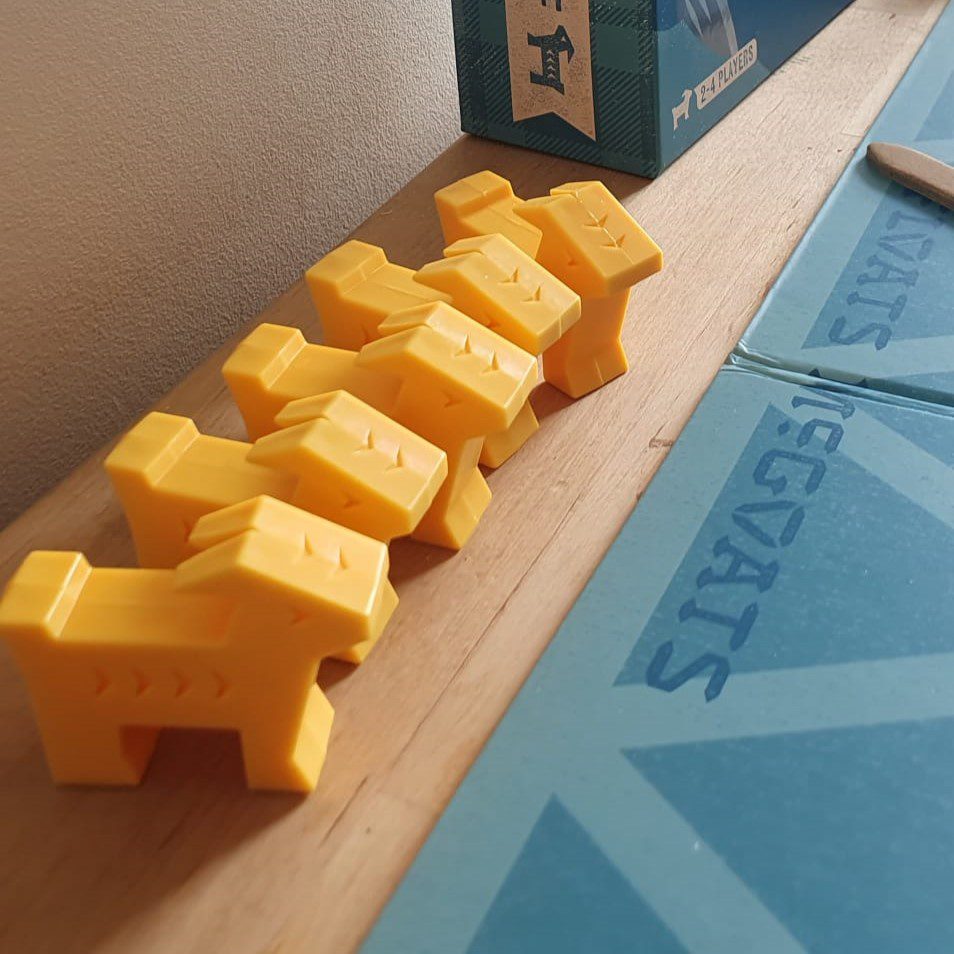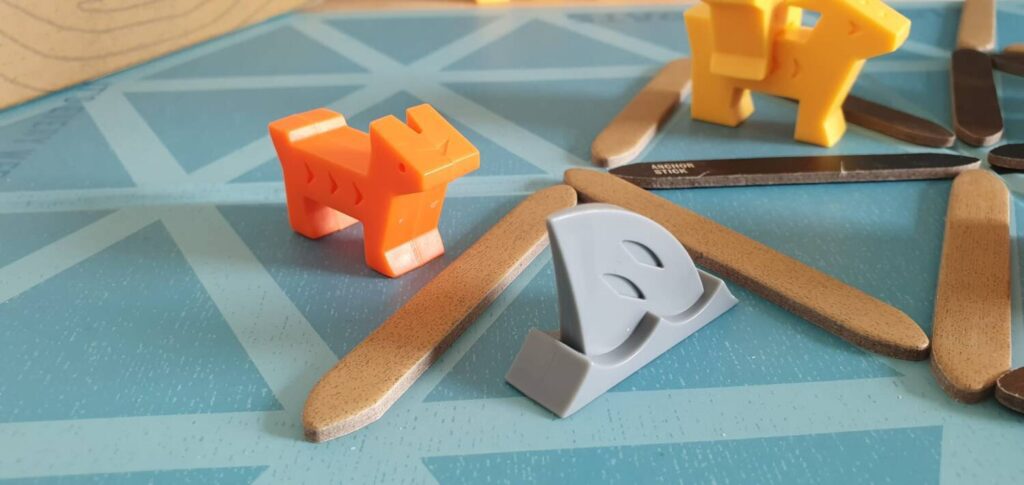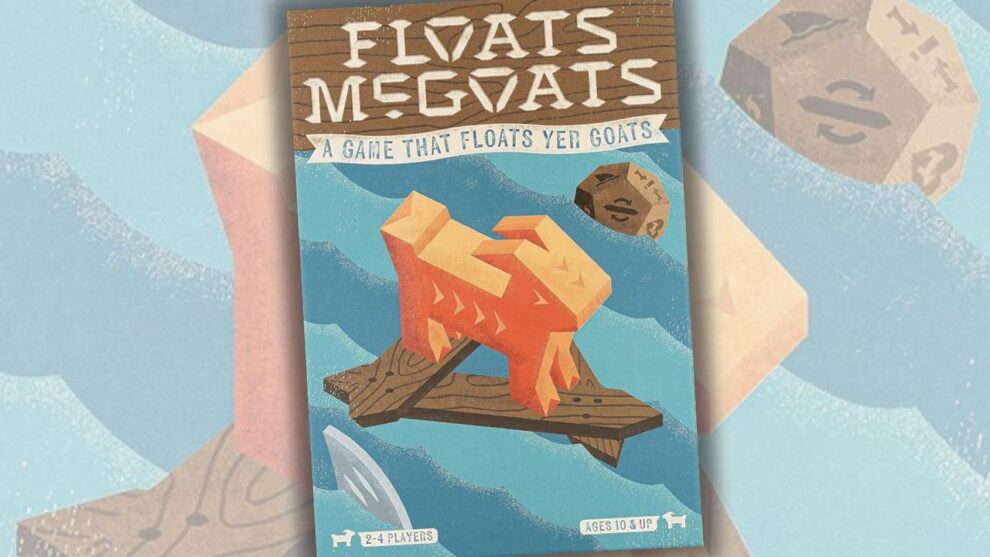Disclosure: Meeple Mountain received a free copy of this product in exchange for an honest, unbiased review. This review is not intended to be an endorsement.
The scene is set thus: “A seafaring goat crew was navigating treacherous waters when their boat capsized! The ship broke apart, leaving wood strewn throughout the waves. To save the goats, players must build a raft from the wood. Each player fights to outsmart the others in a quest to get their goats on the raft. But watch out for the shark lurking in the waters…”
“Outsmart” is somewhat overstating the chaotic to-and-fro of rolling planks and leaping hooves, with the tiller steered as much by the 12-sided die as by player choices. And the obligatory shark in fact may rarely make an appearance.
Like a bagpiper in a submarine
The box is compact, easily portable in your handbag, and the contents fit snugly. The 28 goat pieces (six mamas and one baby, each in four colours) are pleasantly tactile, and stack in a cute way, the mamas carrying the babies across their backs, to protect them from ocean, shark and clan rivals alike. The mama-baby choice of language is perfectly legit, a) because the designer hails from the beautiful Southeastern United States, and b) because daddy goats can sometimes be a danger to kids (fun fact).

The gun-metal fin is fun and the mustard dodecahedron passes muster, but the flimsy sticks, instead of conjuring the illusion of supporting a few hundred kilos of livestock, are rather reminiscent of plant pot labels. Given all the browns are taken already for raft pieces, and blue for the sea, the choice to go flamboyant with the goat tones is understandable – scarlet, tangerine, sunflower and teal complete the zany, party-at-the-end-of-the-world vibe.
The board folds out to a reasonable playing area, but would leave room on the table for your pint. The feel of open water is not quite there, with the tessellated triangles (to mark raft placement) too much in the foreground – solutions could include swapping out the branding (very First Amendment) for some wave motifs, or spinning the colour wheel to Atlantic navy or North Sea grey. Strangely the underside of the board (not used for the game) seems more on-theme, with dark wood colours in a runic pattern befitting of Celtic traders.

The instructions we award top marks for leaving the reader in no doubt how to play, with clear flow and diagrams. They explore each nook and cranny of game scenario permutations and butt out any ambiguity. Poetic it is not, but I don’t think the straight-shootin’ Nashvillians are trying to be.
Jumping the shark
To set up, two ‘anchor sticks’ are placed at the centre, an immutable core around which to build out the makeshift rescue craft. Each turn, a player can choose to either add one of their 7 goats to the vessel, or to roll the dice. As advised in the instructions, early moves should focus on embarking your herd, balanced with adding planks. A goat becomes point-scoring once enclosed by a triangle of three sticks, with more points for the baby and for stacked pairs. With no fixed timings, the winner is simply the first to get 6 points worth of goats on the board (5 points in a 3 or 4 player game).
The die is where the action is. Of the twelve sides, three are the “add a stick” type, two are “add or move a stick”, two “flip a stick”, and one “move two sticks”. The raft has to grow to accommodate sufficient animals to reach the points threshold, but one must try to avoid handing a fresh berth to an opponent. Another twist is that raft pieces are double-sided, starting ‘light’ which means they can be moved, and upgradable (with a lucky dice throw) to ‘dark’ whence they are fixed. A goat staring at three dark walls can breathe a sigh of relief knowing she is now safe from further molestation.

The “goat fight” action (two of 12 faces) sounds promising – a player chooses an enemy beast to trade places with one of their own. The tactic appears to be to move your own brethren to safer quarters whilst pushing stronger rivals towards the taffrail. Adults may not attack kids, nor stacked pairs. Hence the choice of when and where to spawn your baby is also important – particularly as it scores 2 points while lone mamas score only 1.
Rolling the “goat love” side allows you to stack two family members. This again scores 2 points (or the maximum 3 points if you direct the baby to clamber up), and further protects the loved-up duo from attack by anyone other than another stacked pair.
Finally the single “shark attack” face is a grape-shot to clear the poop deck – a playing field leveller reminiscent of the Carcassonne dragon. You may choose any opponent’s piece to send to Davey Jones’ locker, and in subsequent turns occupy their still-warm hammock with a goat of your own.

In principle there is scope for some enjoyable strategy – but the die unfortunately makes that difficult. Billed at 15-30 minutes and for 2-4 players, you might get 6-8 minutes per person and let’s say 10-15 rolls of the die each – a player can too easily go a whole game seeing too few of those more interesting tactical options, and certainly with no choice over which to deploy when.
Och aye the… No.
If creator Hootenanny Games have set out their stall as novelty party diversions, this one does at least fit that brief – summarised one tester “I’ve never played a game about goats on a raft.” They have three other titles out – Sixem, Snarkas and Verses – all appear to be compact, simple, gift shop staples.

Floats McGoats gave us big kids a laugh for the first few games, and the box states ages 10+ which seems fair given the variety of actions. For this old salt there is sadly not enough control or structure for the raft to reach the shore. The gameplay becomes dissatisfying and eventually nihilistic – which upon Kafkaesque reflection actually does fit the theme of a bleak terminal future for abandoned animals doomed to drift until drowned.
The attempt to capture the essence of rural Scotland looks pasty in comparison to for example Isle of Skye: From Chieftain to King or even Block Ness. With the straplines “The game that floats yer goats!” and “It’s every wee goat for themself!”, the research appears to have been light touch, and Tennessee reveals itself to be landlocked and several thousand miles from Orkney. One can forgive a little cultural misappropriation across the pond but here in old Caledonia we are less amused.









Add Comment